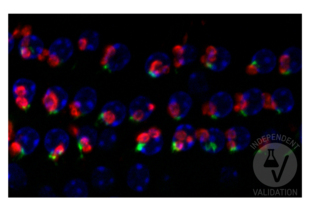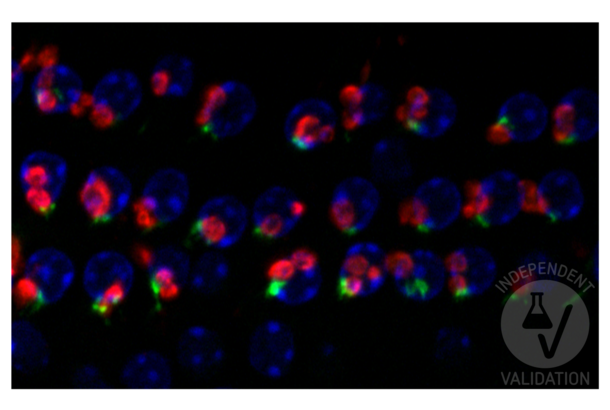Solute Carrier Family 18 (Vesicular Acetylcholine), Member 3 Antikörper

 SLC18A3 Antikörper (C-Term) (ABIN1742304)
SLC18A3 Antikörper (C-Term) (ABIN1742304)
SLC18A3 Reaktivität: Ratte, Maus IHC, WB Wirt: Meerschweinchen Polyclonal unconjugated
SLC18A3 Reaktivität: Human IHC, WB, IF, ICC Wirt: Maus Monoclonal S6-38 unconjugated
SLC18A3 Reaktivität: Human IHC, WB, IF, ICC Wirt: Maus Monoclonal S6-38 HRP
Solute Carrier Family 18 (Vesicular Acetylcholine), Member 3 Antikörper nach Reaktivität
Hier sind Solute Carrier Family 18 (Vesicular Acetylcholine), Member 3 Antikörper für eine Vielzahl von Species wie anti-Human Solute Carrier Family 18 (Vesicular Acetylcholine), Member 3, anti-Rat Solute Carrier Family 18 (Vesicular Acetylcholine), Member 3, anti-Mouse Solute Carrier Family 18 (Vesicular Acetylcholine), Member 3 zu finden. Die unten aufgeführten Species gehören zu den verfügbaren Arten. Klicken Sie auf einen Link, um zu den entsprechenden Produkten zu gelangen.
Solute Carrier Family 18 (Vesicular Acetylcholine), Member 3 Antikörper nach Anwendung
Hier sind Solute Carrier Family 18 (Vesicular Acetylcholine), Member 3 Antikörper zu finden, welche für eine bestimmte Anwendung wie WB, IHC, IF, ICC validiert wurde. Einige der verfügbaren Anwendungen sind unten aufgeführt. Klicken Sie auf einen Link, um zu den entsprechenden Produkten zu gelangen.
Solute Carrier Family 18 (Vesicular Acetylcholine), Member 3 Antikörper nach Wirt
Hier sind Solute Carrier Family 18 (Vesicular Acetylcholine), Member 3 Antikörper mit einem spezifischen Wirt zu finden. Die hier aufgeführten Wirt sind einige der verfügbaren. Ein Klick auf den entsprechenden Link führt zu den Produkten.
Solute Carrier Family 18 (Vesicular Acetylcholine), Member 3 Antikörper nach Bindungsspezifität
Hier sind Solute Carrier Family 18 (Vesicular Acetylcholine), Member 3 Antikörper mit einem bestimmten Epitop aufgelistet. Die unten aufgeführten Epitope gehören zu den verfügbaren Epitopen. Klicken Sie auf einen Link, um zu den entsprechenden Produkten zu gelangen.
Solute Carrier Family 18 (Vesicular Acetylcholine), Member 3 Antikörper nach Klonalität
Finden Sie verfügbare monoklonale oder polyklonale Solute Carrier Family 18 (Vesicular Acetylcholine), Member 3 Antikörper. Klicken Sie auf einen Link, um zu den entsprechenden Produkten zu gelangen.
Solute Carrier Family 18 (Vesicular Acetylcholine), Member 3 Antikörper nach Klon
Hier sind Solute Carrier Family 18 (Vesicular Acetylcholine), Member 3 Antikörper mit einem spezifischen Klon zu finden. Die hier aufgeführten Klon sind einige der verfügbaren. Ein Klick auf den entsprechenden Link führt zu den Produkten.
Solute Carrier Family 18 (Vesicular Acetylcholine), Member 3 Antikörper nach Konjugat
Suchen Sie Solute Carrier Family 18 (Vesicular Acetylcholine), Member 3 Antikörper mit einer bestimmten Konjugation wie Biotin, APC, Alexa Fluor 488. Die unten aufgeführten Konjugate gehören zu den verfügbaren. Klicken Sie auf einen Link, um zu den entsprechenden Produkten zu gelangen.
Häufig verwendete Solute Carrier Family 18 (Vesicular Acetylcholine), Member 3 Antikörper
- (4)
- (3)
- (1)
- (3)
- (3)
- (3)
- (3)
- (3)
- (3)
- (3)
- (3)
- (3)
- (3)
- (3)
- (2)
- (2)
- (1)
Aktuelle Publikationen für unsere Solute Carrier Family 18 (Vesicular Acetylcholine), Member 3 Antikörper
: "Glutamatergic and central cholinergic dysfunction in the CA1, CA2 and CA3 fields on spatial learning and memory in chronic cerebral ischemia-Induced vascular dementia of rats." in: Neuroscience letters, Vol. 620, pp. 169-176, (2016) (PubMed).: "Deletion of neurturin impairs development of cholinergic nerves and heart rate control in postnatal mouse hearts." in: Physiological reports, Vol. 4, Issue 9, (2016) (PubMed).
: "An animal model of Miller Fisher syndrome: Mitochondrial hydrogen peroxide is produced by the autoimmune attack of nerve terminals and activates Schwann cells." in: Neurobiology of disease, Vol. 96, pp. 95-104, (2016) (PubMed).
: "Neuregulin-1 is concentrated in the postsynaptic subsurface cistern of C-bouton inputs to α-motoneurons and altered during motoneuron diseases." in: FASEB journal : official publication of the Federation of American Societies for Experimental Biology, Vol. 28, Issue 8, pp. 3618-32, (2014) (PubMed).
: "Effect of neurturin deficiency on cholinergic and catecholaminergic innervation of the murine eye." in: Experimental eye research, Vol. 122, pp. 32-9, (2014) (PubMed).
: "Individual synaptic vesicles from the electroplaque of Torpedo californica, a classic cholinergic synapse, also contain transporters for glutamate and ATP." in: Physiological reports, Vol. 2, Issue 1, pp. e00206, (2014) (PubMed).
: "Inhibition of neuronal apoptosis and axonal regression ameliorates sympathetic atrophy and hemodynamic alterations in portal hypertensive rats." in: PLoS ONE, Vol. 9, Issue 1, pp. e84374, (2014) (PubMed).
: "Muscarinic cholinergic receptor M1 in the rat basolateral amygdala: ultrastructural localization and synaptic relationships to cholinergic axons." in: The Journal of comparative neurology, Vol. 521, Issue 8, pp. 1743-59, (2013) (PubMed).
: "Forced desynchrony reveals independent contributions of suprachiasmatic oscillators to the daily plasma corticosterone rhythm in male rats." in: PLoS ONE, Vol. 8, Issue 7, pp. e68793, (2013) (PubMed).
: "Genetic deficiency of GABA differentially regulates respiratory and non-respiratory motor neuron development." in: PLoS ONE, Vol. 8, Issue 2, pp. e56257, (2013) (PubMed).
Aliase für Solute Carrier Family 18 (Vesicular Acetylcholine), Member 3 Antikörper
solute carrier family 18 member A3 (Slc18a3) Antikörpersolute carrier family 18 (vesicular acetylcholine transporter), member 3b (slc18a3b) Antikörper
solute carrier family 18 member A3 (SLC18A3) Antikörper
solute carrier family 18 (vesicular monoamine), member 3 (Slc18a3) Antikörper
solute carrier family 18 (vesicular acetylcholine transporter), member 3 (slc18a3) Antikörper
Vesicular acetylcholine transporter (VAChT) Antikörper
solute carrier family 18 (vesicular acetylcholine transporter), member 3a (slc18a3a) Antikörper
CG12345 Antikörper
CG32848 Antikörper
CT41182 Antikörper
Dmel\\CG32848 Antikörper
MGC64220 Antikörper
rVAT Antikörper
Slc18a3 Antikörper
SLC18A3 Antikörper
VACht Antikörper
VACHT Antikörper
VAChT Antikörper
Vacht Antikörper
vAChT Antikörper
vacht Antikörper
VAChT-A Antikörper
VAT Antikörper
zgc:153442 Antikörper
Haben Sie etwas anderes gesucht?
- Solute Carrier Family 17 (Vesicular Glutamate Transporter), Member 6 Antikörper
- Solute Carrier Family 17 (Acidic Sugar Transporter), Member 5 Antikörper
- Solute Carrier Family 16, Member 9 (Monocarboxylic Acid Transporter 9) Antikörper
- Solute Carrier Family 14 (Urea Transporter, Kidney) Member 2 Antikörper
- Soluble Tumor Necrosis Factor Receptor Type 2 Antikörper
- SOHLH2 Antikörper
- SOHLH1 Antikörper
- SOGA1 Antikörper
- Sodium Potassium ATPase, alpha1 Antikörper
- Sodium Channel, Voltage-Gated, Type IV, beta Subunit Antikörper
- Sodium Channel, Nonvoltage-Gated 1, gamma Antikörper
- Sodium Channel, Nonvoltage-Gated 1, beta Antikörper
- SOD4 Antikörper
- SOD3 Antikörper
- SOD2 Antikörper
- SOCS7 Antikörper
- SOCS6 Antikörper
- SOCS5 Antikörper
- SOCS4 Antikörper
- SOCS3 Antikörper
- Solute Carrier Family 22 (Organic Cation Transporter), Member 7 Antikörper
- Solute Carrier Family 25 (Mitochondrial Carrier, Phosphate Carrier), Member 3 Antikörper
- Solute Carrier Family 25, Member 28 Antikörper
- Solute Carrier Family 25, Member 44 Antikörper
- Solute Carrier Family 3 (Activators of Dibasic and Neutral Amino Acid Transport), Member 2 Antikörper
- Solute Carrier Family 3 Member 1 Antikörper
- Solute Carrier Family 30 (Zinc Transporter), Member 1 Antikörper
- Solute Carrier Family 31 (Copper Transporters), Member 2 Antikörper
- Solute Carrier Family 34 (Type II Sodium/phosphate Contransporter), Member 1 Antikörper
- Solute Carrier Family 35 (UDP-GlcNAc/UDP-Glucose Transporter), Member D2 Antikörper
- Solute Carrier Family 38, Member 7 Antikörper
- Solute Carrier Family 39 (Zinc Transporter), Member 9 Antikörper
- Solute Carrier Family 40 (Iron-Regulated Transporter), Member 1 Antikörper
- Solute Carrier Family 43, Member 1 Antikörper
- Solute Carrier Family 43, Member 2 Antikörper
- Solute Carrier Family 5 (Sodium/glucose Cotransporter), Member 12 Antikörper
- Solute Carrier Family 5 (Sodium/inositol Cotransporter), Member 11 Antikörper
- Solute Carrier Family 52 (Riboflavin Transporter), Member 3 Antikörper
- Solute Carrier Family 6 (Neurotransmitter Transporter, serotonin), Member 4 Antikörper
- Solute Carrier Family 6 (Neutral Amino Acid Transporter), Member 19 Antikörper




